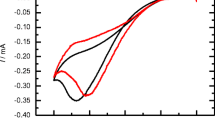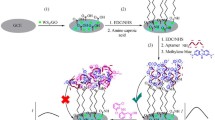Abstract
An electrochemical competition method was used to study the interaction of carbaryl with natural double-stranded DNA (ds-DNA). Layer-by-layer films of negatively charged natural ds-DNA and polycationic poly (diallyldimethylammonium chloride) were assembled on the surface of a glassy carbon electrode. The DNA intercalator [Ru(bpy)2(dppz)]2+ (bpy = 2, 2′-bipyridine, dppz = dipyrido [3, 2-a: 2′,3′-c] phenazine) was chosen as an electrochemical probe. Tripropylamine was used as an electron donor to chemically amplify the oxidation current of the probe. In order to examine the effects of substituting group on the binding interaction of carbaryl with DNA, the interaction of naphthalene or α-naphthol with DNA was also studied by square wave voltammetry (SWV). The values of binding constant K b of the three compounds to DNA are determined, which fall in the range of (0.2 × 105) to (1.3 × 105) M−1. The correlation suggests that the functional groups may play an important role in the DNA/analyte competition binding interaction. We demonstrated that it is conducive to the combination of small molecules and DNA when the functional groups are hydrophobic and have the lone-pair electrons as the electron donor. Furthermore, UV-absorption and fluorescence intensity of Ru-dppz decreases in the presence of carbaryl. These characteristics strongly support the intercalation of carbaryl into double-stranded DNA.









Similar content being viewed by others
References
Henderson L, Albertini S, Aardema M (2000) Mutat Res Genet Toxicol Environ 464:123–128
Babich H, Borenfreund E (1991) Toxicol In Vitro 5:91–100
Zhang Y, Hu NF (2007) Electrochem Commun 9:35–41
Flaskos J, Mclean WG, Hargreaves AJ (1994) Toxicol Lett 70:71–76
Gollapudi BB, Mendrala AL, Linscombe VA (1995) Mutat Res 342:25–36
Leibold E, Schwarz LR (1993) Carcinogenesis 14:2377–2382
Pasquini R, Scassellatisforzolini G, Dolara P, Pampanella L, Villarini M, Caderni G, Fazi M, Fatigoni C (1994) Pharmacol Toxicol 75:170–176
Delescluse C, Ledirac N, Li RY, Piechocki MP, Hines RN, Gidrol X, Rahmani R (2001) Biochem Pharmacol 61:399–407
Sun H, Shen OX, Xu XL, Song L, Wang XR (2008) Toxicology 249:238–242
Rauf S, Gooding JJ, Akhtar K, Ghauri MA, Rahman M, Anwar MA, Khalid AM (2005) J Pharma Biomed 37:205–217
Rivas GA, Pedano ML, Ferreyra NF (2005) Anal Lett 38:2653–2703
Ferreyra NF, Rivas GA (2009) Electroanalysis 21:1665–1671
Arias P, Ferreyra NF, Rivas GA, Bollo S (2009) J Electroanal Chem 634:123–126
Minasyan SH, Tavadyan LA, Antonyan AP, Davtyan HG, Parsadanyan MA, Vardevanyan PO (2006) Bioelectrochemistry 68:48–55
Huang RF, Wang LR, Guo LH (2010) Anal Chim Acta 676:41–45
Dervan PB (2001) Bioorgan Med Chem 9:2215–2235
Graves DE, Velea LM (2000) Curr Org Chem 4:915–929
Shao Z, Li Y, Yang Q, Wang J, Li G (2010) Anal Bioanal Chem 398:2963–2967
Pitterl F, Chervet J, Oberacher H (2010) Anal Bioanal Chem 397:1203–1215
Shah A, Zaheer M, Qureshi R, Akhter Z, Nazar MF (2010) Spectrochim Acta A 75:1082–1087
Wang LR, Qu N, Guo LH (2008) Anal Chem 80:3910–3914
Zeglis BM, Pierre VC, Barton JK (2007) Chem Commun 44:4565–4579
Dickeson JE, Summers LA (1970) Aust J Chem 23:1023–1027
Amouyal E, Homsi A, Chambron JC, Sauvage JP (1990) J Soc Dalton 6:1841–1845
Huang CZ, Li YF, Feng P (2001) Talanta 55:321–328
Kang TF, Wang F, Lu LP, Zhang Y, Liu TS (2010) Sensors Actuators B Chem 145:104–109
Scatchard G (1949) Ann N Y Acad Sci 51:660–672
Cheng YC, Prusoff WH (1973) Biochem Pharmacol 22:3099–3108
Carlson DL, Huchital DH, Mantilla EJ, Sheardy RD, Murphy WR (1993) J Am Chem Soc 115:6424–6425
Friedman AE, Chambron JC, Sauvage JP, Turro NJ, Barton JK (1990) J Am Chem Soc 112:4960–4962
Loontiens FG, Mclaughlin LW, Diekmann S, Clegg RM (1991) Biochemistry 30:182–189
Lerman LS (1961) J Mol Biol 3:18–30
Wang LR, Wang Y, Chen JW, Guo LH (2009) Toxicology 262:250–257
Acknowledgments
The authors thank the financial support from the Key Program of Science and Technology of Beijing Municipal Education Commission (No. KZ201110005006), the Beijing Natural Science Foundation (No. 8102009), the National Natural Science Foundation of China (No. 20247002, No. 21005005) and Beijing Municipal institution of higher learning academic innovating group projects (No. PHR 201007105).
Author information
Authors and Affiliations
Corresponding author
Electronic supplementary material
Below is the link to the electronic supplementary material.
ESM 1
(DOC 58 kb)
Rights and permissions
About this article
Cite this article
Xiong, Y., Kang, TF. & Lu, LP. Electrochemistry of complex formation of carbaryl with ds-DNA using [Ru(bpy)2dppz]2+ as probe. J Solid State Electrochem 17, 129–136 (2013). https://doi.org/10.1007/s10008-012-1861-x
Received:
Revised:
Accepted:
Published:
Issue Date:
DOI: https://doi.org/10.1007/s10008-012-1861-x




